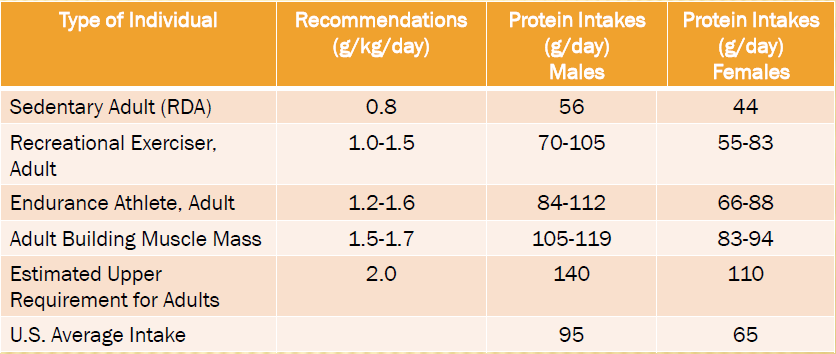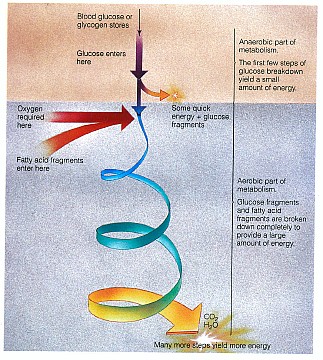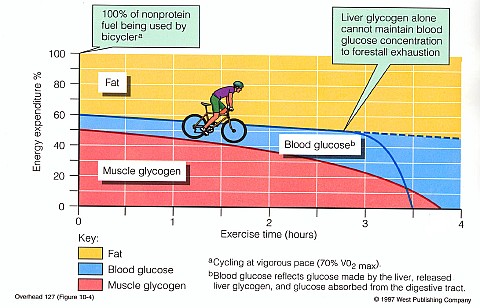Does it represent glycolysis, or does it represent the Krebs cycle?
What does the blue to green to yellow spiraled arrow represent?
Does it represent glycolysis, or does it represent the Krebs cycle?
At the beginning of this bike ride, the rider is using glycogen & fat, but slightly more _________________.
As time goes on, the rider is using more ________ than glycogen.
When does glycogen run out for this bike rider?
Two ways you can manipulate what you do to make glycogen last as long as possible is to:
- Train so you build up the number of
fat-burning enzymes you make. That means you can burn more
fat for energy, conserving glycogen for as long as possible. More highly
trained individuals also make more and larger mitochondria. The
mitochondria is the powerhouse of the cell where aerobic metabolism
takes place.
- Eat plenty of whole foods with
carbohydrate so you have glucose to make glycogen.
Which part of step 5 is anaerobic? If you're still uncertain, watch the Video Clip again.
Anaerobic metabolism is almost entirely glycogen (as well as glucose in the blood) because burning fat requires lots of oxygen.
You should be able to fill these in from the Video Clip.
Ketones are produced when there's not enough __________________ in cells.
Summary of Fuels Used for Activities of Different Intensities and Durations
|
Activity Intensity |
Activity Duration |
Preferred Fuel |
Oxygen Needed? |
Activity Example |
|
Very High |
30 sec. – 3 min. |
Glucose |
No |
Sprinting |
|
High |
3 min. – 20 min. |
Glucose |
Yes |
Jogging |
|
Low to Moderate |
> 20 min. |
Fat |
Yes |
Walking |
A person needs extra protein in the diet if they are regularly exercising. The rule of thumb I use is to double the RDA if you are active, which would mean your protein needs would be 1.6 g/kg/day. (Remember the RDA is 0.8g/kg) The majority of Americans get plenty of protein and don't need to eat special foods to get adequate amounts of protein. See table below:
RECOMMENDED PROTEIN NEEDS

If you are an athlete, the extra protein you need is mainly needed to build and maintain muscle and other lean tissue. If you want to gain 1 pound of muscle per week, you only need 14 grams of extra protein per day, the amount in 2 ounces of meat (Bernardot 1992). Exercise, not extra protein, is the key to developing bigger muscles. Any excess protein that you take in beyond the above recommendations is burned for energy or, stored as glycogen or fat (depending on Calorie intake). Humans do not store excess protein as muscle, protein, or amino acids.
COMMON QUESTIONS REGARDING PROTEIN
1. What’s the concern of too much protein? You’ll crowd out carbohydrates which fuel your muscles. When athletes focus too much on protein, and not enough on carbohydrates they often sacrifice endurance.
2. Do I need to eat as soon as I finish exercising? There is a 45 min. post exercise window to nourish, repair, and build muscles. You can switch out of the muscle breakdown mode by eating a combination of carbohydrate and protein as soon as tolerable after you exercise. Good examples of this are a yogurt and fruit, or a peanut butter sandwich.
3. Do I need to eat protein every 3 to 4 hours to support muscle growth? Yes, when amino acid levels are above normal, the muscles take up more, enhancing muscle growth.
4. Are protein supplements better than real food? Protein supplements are a mindless way to get protein, and are often quick and convenient, but they don't offer any benefit over whole foods. The advantage of getting protein from whole foods is that protein comes packaged the way nature intended, and whole foods also contain phytochemicals and other yet-unknown bioactive compounds that might influence muscle growth. Whole foods are also typically less expensive than protein supplements.
Your lecture outline has a chart comparing
Heat EXHAUSTION and
Heat STROKE
Heat STROKE is more dangerous because the high temperature can denature body proteins, which can lead to loss of brain function and death.
What sports drinks offer besides fluid, to those exercising over one hour:
- Electrolytes like sodium- may accelerate glucose & water absorption from digestive tract. About 225 mg per 12 oz. (150 mg per cup) is enough.
- Glucose: no more than 7%, which is about 23 grams per 12 oz. (15 grams per 1 cup). More sugar than that delays fluid going from the stomach to the small intestine where it can be absorbed.
- Psychological edge
- Taste
Homemade sports drink: 1 qt. water, 1 cup sugar-sweetened fruit juice, 1/3 tsp. salt

